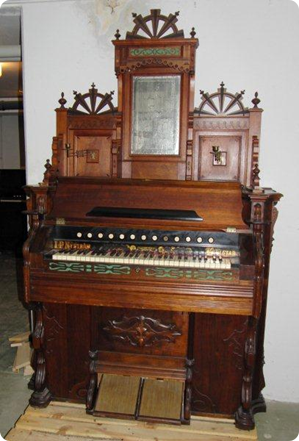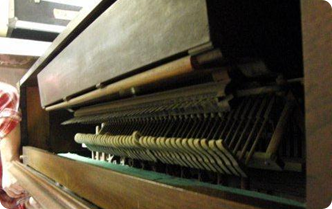Salon Organ (Harmonium with mirror), Mason & Hamlin (USA) c. 1875/ J.P. Nyström c 1895, KH 546
A tall salon harmonium with a mirror attracts attention with its distinctive design (KH 546). It bears a nameplate from J.P. Nyström, but despite this, one gets the impression at first glance that something is not right. The style of the furniture is undoubtedly American, but the top-piece and organ part do not seem to belong together stylistically.
KH investigate the idea that the organ itself, which is made of American walnut, was built on at a later date with a top piece according to partially different stylistic ideals. Could that be true?
Historical investigation
First we need to discover where the organ part comes from: if it is from Nyström as the nameplate says, or from someone else, and if so who.
It turns out unexpectedly this the harmonium is not by Nyström, but American from the Mason & Hamlin factory, Style 302 (Robert F. Gellerman).
Our organ has been tentatively dated to approx. 1875 (Gellerman, e-mail November 28, 2010) and represents evidence of early Swedish import of suction organs from the USA.
The next question then becomes who registered this organ in Sweden. Reasonably, it should be Nyström. The factory Mason & Hamlin is mentioned in Nyström’s 60-yearbook 1865-1925 (p. 9), and this factory is seen there as important (even if Nyström misunderstood the history of the origin of the suction bellows). It is therefore reasonable to imagine that Nyström imported organs from Mason & Hamlin and that this copy for some reason remained unsold in the factory in Karlstad.
Much later, Nyström got the idea to rebuild this instrument and provide it with a tall top with a mirror that has some decorative details in common with his “style 60, 61” in the 1895 catalog (p. 32). The instrument’s nameplate is that used during the period from about 1895 to 1902, when the factory became a limited company. Therefore somewhere during those years, most likely around 1895, the extension is likely to have taken place.
The Instrument
The original instrument has a very special register built into the organ case. In the 1886 price list, Nyström offers “Piano-Organs”, i.e. “Organs with Piano-harp inside”. They have a series of hammers that do not strike against strings but against a series of metal rods, which produce a bell-like sound.
Attempts to replace strings in the piano with other materials (glass, metal) are older and well known. Something similar to Nyströms “piano organ” had been tried by J.B. Cramer & Co in London (“steel piano”, no. 223 is in the Scenkonst Museum in Stockholm, inv. no. M 1793).
A Swedish patent from 1841 taken by the organist and town treasurer in Strömstad J.E. Bäckström uses “icke spända kroppar, i form af wanliga stämgafflar, en för hwarje ton, hwilka förfärdigas företrädeswis, af det finaste stål, wäl fjäderhärdade” (non-tensioned bodies, in the form of ordinary tuning forks, one for each tone, which are made preferentially, of the finest steel, well spring-hardened). This idea was not new, because already in 1803 the Dane Peter Riffelsen had invented his Melodica, where tuning forks were set in swing against a rotating metal roller (Falcon Möller 1983, p. 59).
Some European harmoniums have a percussion effect created by small hammers hitting the reeds. However the mechanism in this instrument is found in a US patent dated December 15, 1874. The Piano Harp Action belonged to Mason & Hamlin’s Model 302, and the patent should be the factory’s own (Gellerman 1973, p. 58).
The model is rare not only here is Sweden, but also in the US.
References:
Falcon Möller, Dorthe, Danske Instrumentbyggere 1770-1850. Köpenhamn 1983.
Gellerman, Robert F., The American Reed Organ. Its History; How it works; How to rebuild it. New York 1973/1997.


